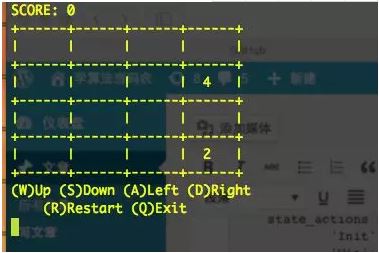首先导入需要的包:
|
1
2
3
|
import cursesfrom random import randrange, choicefrom collections import defaultdict |
主逻辑
用户行为
所有的有效输入都可以转换为"上,下,左,右,游戏重置,退出"这六种行为,用 actions 表示
|
1
|
actions = ['Up', 'Left', 'Down', 'Right', 'Restart', 'Exit'] |
有效输入键是最常见的 W(上),A(左),S(下),D(右),R(重置),Q(退出),这里要考虑到大写键开启的情况,获得有效键值列表:
|
1
|
letter_codes = [ord(ch) for ch in 'WASDRQwasdrq'] |
将输入与行为进行关联:
|
1
|
actionsdict = dict(zip(lettercodes, actions * 2)) |
状态机
处理游戏主逻辑的时候我们会用到一种十分常用的技术:状态机,或者更准确的说是有限状态机(FSM)
你会发现 2048 游戏很容易就能分解成几种状态的转换。

state 存储当前状态, state_actions 这个词典变量作为状态转换的规则,它的 key 是状态,value 是返回下一个状态的函数:
|
1
2
3
4
|
Init: init()Game: game()Win: lambda: not_game('Win')Gameover: lambda: not_game('Gameover') |
Exit: 退出循环
状态机会不断循环,直到达到 Exit 终结状态结束程序。
下面是经过提取的主逻辑的代码,会在后面进行补全:
|
1
2
3
4
5
6
7
8
9
10
11
12
13
14
15
16
17
18
19
20
21
22
23
24
25
26
27
28
29
30
31
32
33
|
def main(stdscr): def init(): #重置游戏棋盘 return 'Game' def not_game(state): #画出 GameOver 或者 Win 的界面 #读取用户输入得到action,判断是重启游戏还是结束游戏 responses = defaultdict(lambda: state) #默认是当前状态,没有行为就会一直在当前界面循环 responses['Restart'], responses['Exit'] = 'Init', 'Exit' #对应不同的行为转换到不同的状态 return responses[action] def game(): #画出当前棋盘状态 #读取用户输入得到action if action == 'Restart': return 'Init' if action == 'Exit': return 'Exit' #if 成功移动了一步: if 游戏胜利了: return 'Win' if 游戏失败了: return 'Gameover' return 'Game' state_actions = { 'Init': init, 'Win': lambda: not_game('Win'), 'Gameover': lambda: not_game('Gameover'), 'Game': game } state = 'Init' #状态机开始循环 while state != 'Exit': state = state_actions[state]() |
用户输入处理
阻塞+循环,直到获得用户有效输入才返回对应行为:
|
1
2
3
4
5
|
def get_user_action(keyboard): char = "N" while char not in actions_dict: char = keyboard.getch() return actions_dict[char] |
矩阵转置与矩阵逆转
加入这两个操作可以大大节省我们的代码量,减少重复劳动,看到后面就知道了。
矩阵转置:
|
1
2
|
def transpose(field): return [list(row) for row in zip(*field)] |
矩阵逆转(不是逆矩阵):
|
1
2
|
def invert(field): return [row[::-1] for row in field] |
创建棋盘
初始化棋盘的参数,可以指定棋盘的高和宽以及游戏胜利条件,默认是最经典的 4×4~2048。
|
1
2
3
4
5
6
7
8
|
class GameField(object): def __init__(self, height=4, width=4, win=2048): self.height = height #高 self.width = width #宽 self.win_value = 2048 #过关分数 self.score = 0 #当前分数 self.highscore = 0 #最高分 self.reset() #棋盘重置 |
棋盘操作
随机生成一个 2 或者 4
|
1
2
3
4
5
6
7
8
9
10
11
12
13
14
15
16
17
18
19
20
21
22
23
24
25
26
27
28
29
30
31
32
33
34
35
36
37
|
def spawn(self): new_element = 4 if randrange(100) > 89 else 2 (i,j) = choice([(i,j) for i in range(self.width) for j in range(self.height) if self.field[i][j] == 0]) self.field[i][j] = new_element#### 重置棋盘 def reset(self): if self.score > self.highscore: self.highscore = self.score self.score = 0 self.field = [[0 for i in range(self.width)] for j in range(self.height)] self.spawn() self.spawn()#### 一行向左合并(注:这一操作是在 move 内定义的,拆出来是为了方便阅读)def move_row_left(row): def tighten(row): # 把零散的非零单元挤到一块 new_row = [i for i in row if i != 0] new_row += [0 for i in range(len(row) - len(new_row))] return new_row def merge(row): # 对邻近元素进行合并 pair = False new_row = [] for i in range(len(row)): if pair: new_row.append(2 * row[i]) self.score += 2 * row[i] pair = False else: if i + 1 < len(row) and row[i] == row[i + 1]: pair = True new_row.append(0) else: new_row.append(row[i]) assert len(new_row) == len(row) return new_row #先挤到一块再合并再挤到一块 return tighten(merge(tighten(row))) |
棋盘走一步
通过对矩阵进行转置与逆转,可以直接从左移得到其余三个方向的移动操作
|
1
2
3
4
5
6
7
8
9
10
11
12
13
14
15
|
def move(self, direction): def move_row_left(row): #一行向左合并 moves = {} moves['Left'] = lambda field: [move_row_left(row) for row in field] moves['Right'] = lambda field: invert(moves['Left'](invert(field))) moves['Up'] = lambda field: transpose(moves['Left'](transpose(field))) moves['Down'] = lambda field: transpose(moves['Right'](transpose(field))) if direction in moves: if self.move_is_possible(direction): self.field = moves[direction](self.field) self.spawn() return True else: return False |
判断输赢
|
1
2
3
4
5
6
7
8
9
10
11
12
13
14
15
16
17
18
19
20
21
22
23
|
def is_win(self): return any(any(i >= self.win_value for i in row) for row in self.field) def is_gameover(self): return not any(self.move_is_possible(move) for move in actions)#### 判断能否移动def move_is_possible(self, direction): defrow_is_left_movable(row): def change(i): if row[i] == 0 and row[i + 1] != 0: # 可以移动 return True if row[i] != 0 and row[i + 1] == row[i]: # 可以合并 return True return False return any(change(i) for i in range(len(row) - 1)) check = {} check['Left'] = lambda field: any(row_is_left_movable(row) for row in field) check['Right'] = lambda field: check['Left'](invert(field)) check['Up'] = lambda field: check['Left'](transpose(field)) check['Down'] = lambda field: check['Right'](transpose(field)) if direction in check: return check[direction](self.field) else: return False |
绘制游戏界面
|
1
2
3
4
5
6
7
8
9
10
11
12
13
14
15
16
17
18
19
20
21
22
23
24
25
26
27
28
29
30
31
32
33
|
def draw(self, screen): help_string1 = '(W)Up (S)Down (A)Left (D)Right' help_string2 = ' (R)Restart (Q)Exit' gameover_string = ' GAME OVER' win_string = ' YOU WIN!' def cast(string): screen.addstr(string + 'n') #绘制水平分割线 def draw_hor_separator(): line = '+' + ('+------' * self.width + '+')[1:] separator = defaultdict(lambda: line) if not hasattr(draw_hor_separator, "counter"): draw_hor_separator.counter = 0 cast(separator[draw_hor_separator.counter]) draw_hor_separator.counter += 1 def draw_row(row): cast(''.join('|{: ^5} '.format(num) if num > 0 else '| ' for num in row) + '|') screen.clear() cast('SCORE: ' + str(self.score)) if 0 != self.highscore: cast('HGHSCORE: ' + str(self.highscore)) for row in self.field: draw_hor_separator() draw_row(row) draw_hor_separator() if self.is_win(): cast(win_string) else: if self.is_gameover(): cast(gameover_string) else: cast(help_string1) cast(help_string2) |
完成主逻辑
完成以上工作后,我们就可以补完主逻辑了!
|
1
2
3
4
5
6
7
8
9
10
11
12
13
14
15
16
17
18
19
20
21
22
23
24
25
26
27
28
29
30
31
32
33
34
35
36
37
38
39
40
|
def main(stdscr): def init(): #重置游戏棋盘 game_field.reset() return 'Game' def not_game(state): #画出 GameOver 或者 Win 的界面 game_field.draw(stdscr) #读取用户输入得到action,判断是重启游戏还是结束游戏 action = get_user_action(stdscr) responses = defaultdict(lambda: state) #默认是当前状态,没有行为就会一直在当前界面循环 responses['Restart'], responses['Exit'] = 'Init', 'Exit' #对应不同的行为转换到不同的状态 return responses[action] def game(): #画出当前棋盘状态 game_field.draw(stdscr) #读取用户输入得到action action = get_user_action(stdscr) if action == 'Restart': return 'Init' if action == 'Exit': return 'Exit' if game_field.move(action): # move successful if game_field.is_win(): return 'Win' if game_field.is_gameover(): return 'Gameover' return 'Game' state_actions = { 'Init': init, 'Win': lambda: not_game('Win'), 'Gameover': lambda: not_game('Gameover'), 'Game': game } curses.use_default_colors() game_field = GameField(win=32) state = 'Init' #状态机开始循环 while state != 'Exit': state = state_actions[state]() |
运行
填上最后一行代码:
|
1
|
curses.wrapper(main) |

完整版代码地址:https://github.com/JLUNeverMore/easy_2048-in-200-lines
总结
以上所述是小编给大家介绍的200 行python 代码实现 2048 游戏,希望对大家有所帮助,如果大家有任何疑问请给我留言,小编会及时回复大家的。在此也非常感谢大家对服务器之家网站的支持!










